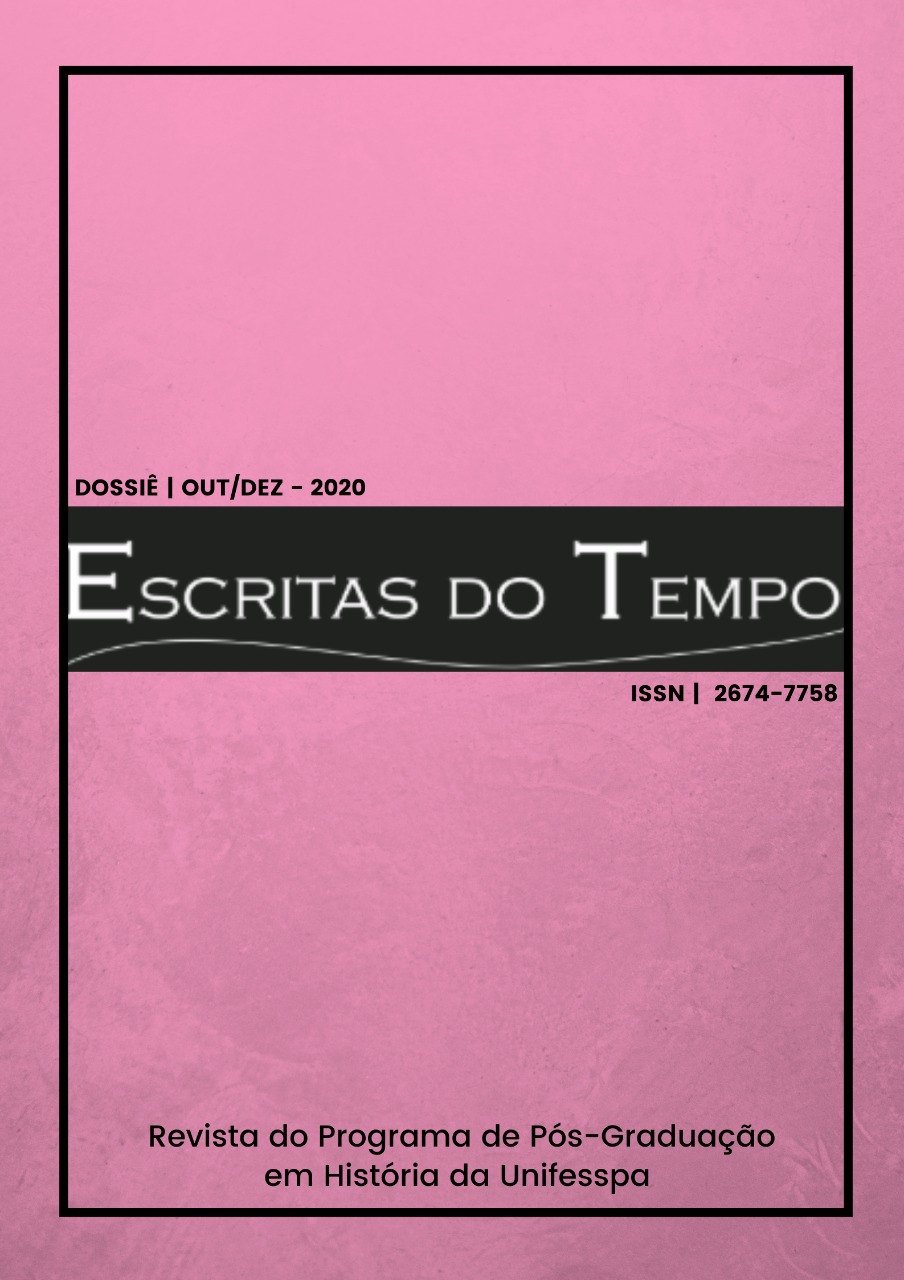Panoramas recentes do Feminismo na Interseccionalidade
DOI:
https://doi.org/10.47694/issn.2674-7758.v2.i6.2020.238256Palavras-chave:
Feminismo, Interseccionalidade, GêneroResumo
O presente artigo foi redigido originalmente em inglês, cujo título é Recent feminist outlooks on intersectionality, de autoria da professora e pesquisadora Sirma Bilge, publicado na Diogenes. Trata-se de uma discussão interessada em teorizar o conceito de interseccionalidade a partir da operacionalização do gênero nos estudos feministas.
Downloads
Referências
Acker, J. (2006b) Class Questions, Feminist Answers. Lanham: Rowman & Littlefield.
Anthias, F. and Yuval-Davis, N. (1992) Racialized Boundaries: Race, Nation, Gender, Colour & Class and the Anti-Racist Struggle. London: Routledge.
Bakhtin, M. (1981) The Dialogic Imagination. Four Essays. Austin: Texas UP.
Bilge, S. (in press) ‘De l’analogie à l’articulation: théoriser la domination sociale et l’inégalité complexe,’ L’homme et la société.
Brah, A. and Phoenix, A. (2004) ‘Ain’t I a Woman? Revisiting Intersectionality,’, Journal of International Women’s Studies, 5(3): 75–86.
Buitelaar, M. (2006) ‘“I am the Ultimate Challenge”. Accounts of Intersectionality in the Life-Story of a Well-Known Daughter of Moroccan Migrant Workers in the Netherlands,’ European Journal of Women’s Studies 13(3): 259–276.
Collins, P. H. (1998) Fighting Words: Black Women and the Search for Justice. Minneapolis: Minnesota UP.
Collins, P. H. (2000) Black Feminist Thought: Knowledge, Consciousness, and the Politics of Empowerment [1990].
New York: Routledge.
Collins, P. H. (2009) ‘Foreword. Emerging Intersections. Building Knowledge and Transforming Institutions,’ in B. Dill and R. Zambana (eds) Emerging Intersections. Race, Class and Gender in Theory, Policy and Practice, p. VII–XIII. New Brunswick, NJ: Rutgers UP.
Crenshaw, K. (1989) ‘Demarginalizing the Intersection of Race and Sex: a Black Feminist Critique of Discrimination Doctrine, Feminist Theory and Antiracist Practice,’ University of Chicago Legal Forum, 89: 139–167.
Crenshaw, K. (1991) ‘Mapping the Margins: Intersectionality, Identity Politics, and Violence against Women of Color,’ Stanford Law Review, 43(6): 1241–1299.
Davis, K. (2008) ‘Intersectionality as Buzzword: A Sociology of Science Perspective on What Makes a Feminist Theory Successful,’ Feminist Theory, 9(1): 67–85.
Denis, A. (2008) ‘Intersectional Analysis: A Contribution of Feminism to Sociology,’ International Sociology, 23(5): 677–694.
Derrida, J. (1990) ‘Some Statements and Truisms about Neologisms, Newisms, Postisms, Parasitisms and other Small Seismisms,’ in David Carroll (ed.) The States of Theory: History, Art, and Critical Discourse, p. 63–95. Stanford, CA: Stanford UP.
Dill, B. T. and Zambana, R. E. (2009) ‘Critical Thinking about Inequality. An Emerging Lens,’ in B. T. Dill and R. E. Zambana (eds) Emerging Intersections. Race, Class and Gender in Theory, Policy and Practice, p. 1–21. New Brunswick, NJ: Rutgers UP.
Egeland, C. and Gressgård, R. (2007) ‘The “Will to Empower”: Managing the Complexity of the Others,’ Nora. Nordic Journal of Women’s Studies, 15: 207–219.
Faber, S. T. (2005) ‘Towards an Intersectional Analysis of Gender and Class on the Basis of Bourdieu’s Sociology,’ Aalborg: Aalborg University, www.ruc.dk/upload/application/pdf/dae84ec7/Faber.pdf. Foucault, M. (1997) Il faut défendre la société. Cours au Collège de France, 1975–1976. Paris: Gallimard-Seuil-EHESS.
Gimenez, M. (2001) ‘Marxism and Class, Gender and Race: Rethinking the Trilogy,’ Race, Gender and Class, 8(2): 23–33.
Gressgård, R. (2008) ‘Mind the Gap: Intersectionality, Complexity and “the Event”,’ Theory and Science, 10(1): 1–16 theoryandscience.icaap.org/content/vol10.1/Gressgard.html.
Hall, S. (1980) ‘Race, Articulation and Societies Structured in Dominance,’ in Coll., Sociological Theories: Race and Colonialism, p. 305–345. Paris: UNESCO.
Hall, S. (1985) ‘Signification, Representation and Ideology; Althusser and the Post-structuralist Debates,’ Critical Studies in Mass Communication, 2(2): 91–114.
Hall, S. (1986) ‘Gramsci’s Relevance for the Study of Race and Ethnicity,’ Journal of Communication Inquiry, 10(2): 5–27.
Hall, S. (1997) ‘The Spectacle of the “Other”,’ in S. Hall (ed.), Representation: Cultural Representations and Signifying Practices, p. 223–279. London: Sage/Open UP.
Hall, S. (2007) ‘Nouvelles ethnicités’ [1989], in Id., Identités et cultures. Politiques des Cultural Studies, p. 203-213. Paris: Amsterdam.
Hancock, A-M. (2007) ‘Intersectionality as a Normative and Empirical Paradigm,’ Politics and Gender, 3(2): 248–254.
Hankivsky, O. and Christoffersen, A. (2008) ‘Intersectionality and the Determinants of Health: a Canadian Perspective,’ Critical Public Health, 18(3): 271–283.
Henderson, D. and Tickamayer, A. (2009) ‘The Intersection of Poverty Discourses: Race, Class, Culture and Gender,’ in B. Dill and R. Zambana (eds) Emerging Intersections. Race, Class and Gender in Theory, Policy and Practice, p. 73–100. New Brunswick, NJ: Rutgers UP.
Hermans, H. and Kempen, H. (1993) The Dialogical Self: Meaning as Movement. San Diego, CA: Academic Press.
Juteau, D. (1994) ‘De la fragmentation à l’unité: vers l’articulation des rapports sociaux,’ L’égalitarisme en question. Cahiers de recherche éthique, 18: 81–108.
Knapp, G.-A. (2005) ‘Race, Class, Gender: Reclaiming Baggage in Fast Travelling Theories,’ European Journal of Women’s Studies, 12: 249–265.
Knudsen, S. V. (2006) ‘Intersectionality – A Theoretical Inspiration in the Analysis of Minority Cultures and Identities in Textbooks,’ in Caught in the Web or Lost in the Textbook? 8th International Conference on Learning and Educational Media, www.caen.iufm.fr/colloque_iartem/pdf/knudsen.pdf.
Kofoed, J. (2008) ‘Appropriate Pupilness: Social Categories Intersecting in School,’ Childhood, 15(3): 415-430.
Laclau, E. and Mouffe, C. (1985) Hegemony and Socialist Strategy. London: Verso.
Mann, S. A. and Huffman, D. J. (2005) ‘The Decentering of Second Wave Feminism and the Rise of the Third Wave,’ Science and Society, 69(1): 56–91.
Maynard, M. (1994) ‘“Race”, Gender and the Concept of “Difference” in Feminist Thought,’ in H. Afshar and M. Maynard (eds) The Dynamics of ‘Race’ and Gender: Some Feminist Interventions, p. 9–25, London: Taylor & Francis.
McAll, C. (1990) Class, Ethnicity and Social Inequality. Montreal & Kingston: McGill-Queen’s UP.
McCall, L. (2005) ‘The Complexity of Intersectionality,’ Signs: Journal of Women in Culture and Society, 30(3): 1771–1800.
Prins, B. (2006) ‘Narrative Accounts of Origins: A Blind Spot in the Intersectional Approach?’ European Journal of Women’s Studies, 13(3): 277–290.
Siltanen, J. and Doucet, A. (2008) Gender Relations in Canada. Intersectionality and Beyond. Toronto: Oxford UP.
Skeggs, B. (1997) Formations of Class and Gender. London: Sage Publications.
Stasiulis, D. (1999) ‘Feminist Intersectional Theorizing,’ in P. Li (ed.), Race and Ethnic Relations in Canada, p. 347–397. Toronto: Oxford UP.
Staunæs, D. (2003) ‘Where have All the Subjects Gone? Bringing Together the Concepts of Intersectionality and Subjectification,’ Nora. Nordic Journal of Women Studies, 11: 101–110.
Therborn, G. (2000) ‘At the Birth of Second Century Sociology: Times of Reflexivity, Spaces of Identity and Nodes of Knowledge,’ British Journal of Sociology, 51: 37–59. Vakulento, A. (2007) ‘“Islamic Headscarves” and the European Convention on Human Rights: An Intersectional Perspective,’ Social Legal Studies, 16: 183–199.
Walby, S. (2007) ‘Complexity Theory, Systems Theory, and Multiple Intersecting Social Inequalities,’ Philosophy of the Social Sciences, 37(4): 449–470.
Weber, L. (2001) Understanding Race, Class, Gender and Sexuality: A Conceptual Framework. New York: McGraw-Hill.
Weber, L. and Parra-Medina, D. (2003) ‘Intersectionality and Women’s Health: Charting a Path to Eliminating Health Disparities,’ in M. Texler Segal, V. Demos, and J. Jacobs Kronenfeld (eds) Gender Perspectives on Health and Medicine: Key Themes, p. 181–229. Oxford: Elsevier.
Yuval-Davis, N. (2006) ‘Intersectionality and Feminist Politics,’ European Journal of Women’s Studies, 13(3): 193–209.
Downloads
Publicado
Como Citar
Edição
Seção
Licença

Este obra está licenciado com uma Licença Creative Commons Atribuição 4.0 Internacional.


_(2).jpg)

1.png)
.png)
.png)
.jpg)
_(1).jpg)
_(1)_(1).jpg)
2.png)
